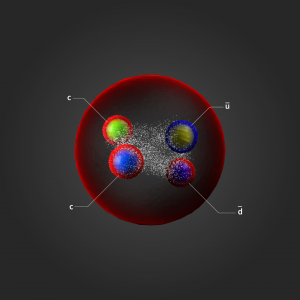The LHCb collaboration has announced the discovery of a bound state of two c quarks, and two light antiquarks (u and d). This type of state is called tetraquark. The first theoretical works studying this possible state date from 1981 (published in 1982), and were initiated by Jean-Pierre Ader (University of Bordeaux), Pierre Taxil (University of Neuchâtel), and Jean-Marc Richard, from IP2I (then in Orsay, on secondment to CERN).
Quarks are the basic constituents of matter. They assemble to form hadrons, i.e. baryons composed of three quarks (like the proton and the neutron) and mesons, formed of quark-antiquark pairs. In recent years, a number of so-called exotic hadrons have been discovered: particles composed of four or five quarks instead of the usual two or three. The new particle contains two c quarks as well as a u antiquark and a d antiquark. Several tetraquarks have been discovered in recent years, but this is the first tetraquark to contain two c quarks, without a compensating c antiquark. This is what physicists call the “open charm”. Moreover, it is the first particle discovered to date belonging to a category of tetraquarks with two heavy quarks and two light antiquarks (category predicted in the article of Jean Marc Richard).
After 40 years the models can finally be confronted with experimental data. No doubt that there are still many things to learn about tetraquarks!
More on the subject:
Twice the charm: long-lived exotic particle discovered
Les surprises du tétraquark, « collage » de particules élémentaires (article of Le Monde, paid access, in French)
The theoretical prediction published in 1982 Do narrow heavy multiquark states exist?

